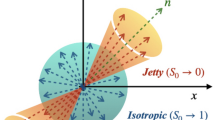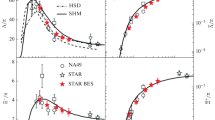Abstract
The Cooling Storage Ring external-target experiment (CEE) spectrometer is used to study the nuclear matter created in heavy-ion collisions at \(\sqrt{s_{_{\mathrm{{NN}}}}}\) = 2.1–2.4 GeV with the aim to reveal the quantum chromodynamics phase structure in the high-baryon-density region. Collective flow is considered an effective probe for evaluating the properties of media during high-energy nuclear collisions. One of the main functions of the zero-degree calorimeter (ZDC), a subdetector system in the CEE, is to determine the reaction plane in heavy-ion collisions. This step is crucial for measuring the collective flow and other reaction-plane-related analyses. In this paper, we illustrate the procedures for event plane determination using the ZDC. Finally, isospin-dependent quantum molecular dynamics model-based predictions of the rapidity dependence of the directed and elliptical flows for p, d, t, \(^3\)He, and \(^4\)He, produced in 2.1 GeV U + U collisions, are presented.









Similar content being viewed by others
Data availability
The data that support the findings of this study are openly available in Science Data Bank at https://doi.org/10.57760/sciencedb.09132 and https://cstr.cn/31253.11.sciencedb.09132.
Notes
Unlike in the experiment, the centrality here is determined from the impact parameter in the model calculations.
References
P.B. Munzinger, J. Stachel, The quest for the quark–gluon plasma. Nature 448, 302–309 (2007). https://doi.org/10.1038/nature06080
I. Arsene, I.G. Bearden, D. Beavis et al., Quark gluon plasma and color glass condensate at RHIC? Perspective of the BRAHMS experiment. Nucl. Phys. A 757, 1–27 (2005). https://doi.org/10.1016/j.nuclphysa.2005.02.130
B.B. Back, M.D. Baker, M. Ballintijn et al., The PHOBOS perspective on discoveries at RHIC. Nucl. Phys. A 757, 28–101 (2005). https://doi.org/10.1016/j.nuclphysa.2005.03.084
K. Adcox, S.S. Adler, S. Afanasiev et al., Formation of dense partonic matter in relativistic nucleus–nucleus collisions at RHIC: experimental evaluation by the PHENIX collaboration. Nucl. Phys. A 757, 184–283 (2005). https://doi.org/10.1016/j.nuclphysa.2005.03.086
J. Adams, M.M. Aggarwal, Z. Ahammed et al., Experimental and theoretical challenges in the search for the quark gluon plasma: the STAR collaboration’s critical assessment of the evidence from RHIC collisions. Nucl. Phys. A 757, 102–183 (2005). https://doi.org/10.1016/j.nuclphysa.2005.03.085
A. Bazavov, T. Bhattacharya, M. Cheng et al., Chiral and deconfinement aspects of the QCD transition. Phys. Rev. D 85, 054503 (2012). https://doi.org/10.1103/PhysRevD.85.054503
K. Fukushima, C. Sasaki, The phase diagram of nuclear and quark matter at high baryon density. Prog. Part. Nucl. Phys 72, 99–154 (2013). https://doi.org/10.1016/j.ppnp.2013.05.003
Y. Aoki, G. Endrodi, Z. Fodor et al., The Order of the quantum chromodynamics transition predicted by the standard model of particle physics. Nature 443, 675–678 (2006). https://doi.org/10.1038/nature05120
K. Fukushima, T. Hatsuda, The phase diagram of dense QCD. Rept. Prog. Phys. 74, 014001 (2011). https://doi.org/10.1088/0034-4885/74/1/014001
A. Bzdak, S. Esumi, V. Koch et al., Map** the phases of quantum chromodynamics with beam energy scan. Phys. Rept. 853, 1–87 (2020). https://doi.org/10.1016/j.physrep.2020.01.005
X. Luo, S. Shi, N. Xu et al., A study of the properties of the QCD phase diagram in high-energy nuclear collisions. Particle 3(2), 278–307 (2020). https://doi.org/10.3390/particles3020022
H.Z. Huang, F. Liu, X.F. Luo et al., Collective excitation in high-energy nuclear collisions—in memory of professor Lianshou Liu. Symmetry 15, 499 (2023). https://doi.org/10.3390/sym15020499
L. Lü, H. Yi, Z.G. **ao et al., Conceptual design of the HIRFL-CSR external-target experiment. Sci. China Phys. Mech. Astron. 60(1), 012021 (2017). https://doi.org/10.1007/s11433-016-0342-x
C.J. Horowitz, E.F. Brown, Y. Kim et al., A way forward in the study of the symmetry energy: experiment, theory, and observation. J. Phys. G 41, 093001 (2014). https://doi.org/10.1088/0954-3899/41/9/093001
S. Zhang, J.H. Chen, H. Crawford et al., Searching for onset of deconfinement via hypernuclei and baryon-strangeness correlations. Phys. Lett. B 684, 224–227 (2010). https://doi.org/10.1016/j.physletb.2010.01.034
A. Andronic, D. Blaschke, P. Braun-Munzinger et al., Hadron production in ultra-relativistic nuclear collisions: quarkyonic matter and a triple point in the phase diagram of QCD. Nucl. Phys. A 837, 65–86 (2010). https://doi.org/10.1016/j.nuclphysa.2010.02.005
S.A. Voloshin, A.M. Poskanzer, R. Snellings, Collective phenomena in non-central nuclear collisions. Landolt-Bornstein 23, 293–333 (2010). https://doi.org/10.1007/978-3-642-01539-7_10
S.A. Bass, M. Belkacem, M. Bleicher et al., Microscopic models for ultrarelativistic heavy ion collisions. Prog. Part. Nucl. Phys. 41, 255–369 (1998). https://doi.org/10.1016/S0146-6410(98)00058-1
J. Steinheimer, A. Motornenko, A. Sorensen et al., The high-density equation of state in heavy-ion collisions: constraints from proton flow. Eur. Phys. J. C 82(10), 911 (2022). https://doi.org/10.1140/epjc/s10052-022-10894-w
D. Oliinychenko, A. Sorensen, V. Koch et al., Sensitivity of Au+Au collisions to the symmetric nuclear matter equation of state at 2–5 nuclear saturation densities. ar**v:2208.11996
L. Adamczyk, J.K. Adkins, G. Agakishiev et al., Centrality and transverse momentum dependence of elliptic flow of multistrange hadrons and \(\phi\) meson in Au+Au collisions at \(\sqrt{s_{_{{\rm {NN}}}}}\) = 200 GeV. Phys. Rev. Lett. 116(6), 062301 (2016). https://doi.org/10.1103/PhysRevLett.116.062301
L. Adamczyk, J.K. Adkins, G. Agakishiev et al., Measurement of \(D^0\) azimuthal anisotropy at midrapidity in Au+Au collisions at \(\sqrt{s_{_{{\rm {NN}}}}}\) = 200 GeV. Phys. Rev. Lett. 118(21), 212301 (2017). https://doi.org/10.1103/PhysRevLett.118.212301
S. Shi, An experimental review on elliptic flow of strange and multistrange hadrons in relativistic heavy ion collisions. Adv. High Energy Phys. 2016, 1987432 (2016). https://doi.org/10.1155/2016/1987432
Y. Nara, A. Ohnishi, Mean-field update in the JAM microscopic transport model: mean-field effects on collective flow in high-energy heavy-ion collisions at \(\sqrt{s_{_{{\rm {NN}}}}}\) = 2–20 GeV energies. Phys. Rev. C 105(1), 014911 (2022). https://doi.org/10.1103/PhysRevC.105.014911
Y. Nara, A. **no, K. Murase et al., Directed flow of \(\Lambda\) in high-energy heavy-ion collisions and \(\Lambda\) potential in dense nuclear matter. Phys. Rev. C 106(4), 044902 (2022). https://doi.org/10.1103/PhysRevC.106.044902
S. Lan, S. Shi, Anisotropic flow in high baryon density region. Nucl. Sci. Tech. 33(3), 21 (2022). https://doi.org/10.1007/s41365-022-01006-0
L. Adamczyk, J.K. Adkins, G. Agakishiev et al., Beam-energy dependence of the directed flow of protons, antiprotons, and pions in Au+Au collisions. Phys. Rev. Lett. 112(16), 162301 (2014). https://doi.org/10.1103/PhysRevLett.112.162301
M.S. Abdallah, B.E. Aboona, J. Adam et al., Disappearance of partonic collectivity in \(\sqrt{s_{_{{\rm {NN}}}}}\) = 3 GeV Au+Au collisions at RHIC. Phys. Lett. B 827, 137003 (2022). https://doi.org/10.1016/j.physletb.2022.137003
H. Elfner, J.Y. Jia, Z.W. Lin et al., Dynamical evolution of heavy-ion collisions, in Properties of QCD Matter at High Baryon Density. ed. by X. Luo, Q. Wang, N. Xu, P. Zhuang (Springer, Singapore, 2022). https://doi.org/10.1007/978-981-19-4441-3_3
L. Adamczyk, J.K. Adkins, G. Agakishiev et al., Beam-energy-dependent two-pion interferometry and the freeze-out eccentricity of pions measured in heavy ion collisions at the STAR detector. Phys. Rev. C 92, 014904 (2015). https://doi.org/10.1103/PhysRevC.92.014904
K. Fukushima, D.E. Kharzeev, H.J. Warringa et al., The chiral magnetic effect. Phys. Rev. D 78, 074033 (2008). https://doi.org/10.1103/PhysRevD.78.074033
L. Adamczyk, J. Adam, L. Adamczyk et al., Search for the chiral magnetic effect via charge-dependent azimuthal correlations relative to spectator and participant planes in \({\rm Au}+{\rm Au}\) collisions at \(\sqrt{s_{_{{\rm {NN}}}}}\) = 200 \(\rm GeV\). Phys. Rev. Lett. 128, 092301 (2022). https://doi.org/10.1103/PhysRevLett.128.092301
X. Zhao, G. Ma, Search for the chiral magnetic effect in collisions between two isobars with deformed and neutron-rich nuclear structures. Phys. Rev. C 106(3), 034909 (2022). https://doi.org/10.1103/PhysRevC.106.034909
B. Chen, X. Zhao, G. Ma, On the difference between signal and background of the chiral magnetic effect relative to spectator and participant planes in isobar collisions at \(\sqrt{s_{_{{\rm {NN}}}}}\) = 200 GeV. ar**v:2301.12076
C. Hartnack, R.K. Puri, J. Aichelin et al., Modeling the many body dynamics of heavy ion collisions: present status and future perspective. Eur. Phys. J. A 1, 151–169 (1998). https://doi.org/10.1007/s100500050045
H. Wang et al., Design and tests of the prototype a beam monitor of the CSR external target experiment. Nucl. Sci. Tech. 33(3), 36 (2022). https://doi.org/10.1007/s41365-022-01021-1
W. Huang, F. Lu, H. Li et al., Laser test of the prototype of CEE time projection chamber. Nucl. Sci. Tech. 29(3), 41 (2018). https://doi.org/10.1007/s41365-018-0382-4
D.D. Hu, J.M. Lu, J. Zhou et al., Extensive beam test study of prototype MRPCs for the T0 detector at the CSR external-target experiment. Eur. Phys. J. C 80(3), 282 (2020). https://doi.org/10.1140/epjc/s10052-020-7804-2
X. Wang, D. Hu, M. Shao et al., CEE inner TOF prototype design and preliminary test results. JINST 17(09), P09023 (2022). https://doi.org/10.1088/1748-0221/17/09/P09023
B. Wang, D. Han, Y. Wang et al., The CEE-eTOF wall constructed with new sealed MRPC. JINST 15(08), C08022 (2020). https://doi.org/10.1088/1748-0221/15/08/C08022
L. Lyu, H. Yi, L. Duan et al., Simulation and prototype testing of multi-wire drift chamber arrays for the CEE. Nucl. Sci. Tech. 31(1), 11 (2020). https://doi.org/10.1007/s41365-019-0716-x
S.H. Zhu, H.B. Yang, H. Pei et al., Prototype design of readout electronics for Zero Degree Calorimeter in the HIRFL-CSR external-target experiment. JINST 16(08), P08014 (2021). https://doi.org/10.1088/1748-0221/16/08/P08014
Saint-Gobain, BC-408 material. https://www.crystals.saint-gobain.com/radiation-detection-scintillators/plastic-scintillators/bc400-bc404-bc408-bc412-bc416
J. Adams, A. Ewigleben, S. Garrett et al., The STAR event plane detector. Nucl. Instrum. Meth. A 968, 163970 (2020). https://doi.org/10.1016/j.nima.2020.163970
J. Aichelin, ‘Quantum’ molecular dynamics: a Dynamical microscopic n-body approach to investigate fragment formation and the nuclear equation of state in heavy-ion collisions. Phys. Rept. 202, 233–360 (1991). https://doi.org/10.1016/0370-1573(91)90094-3
R. Brun, F. Bruyant, F. Carminati et al., GEANT detector description and simulation tool. (1994). https://doi.org/10.17181/CERN.MUHF.DMJ1
A.M. Poskanzer, S.A. Voloshin, Methods for analyzing anisotropic flow in relativistic nuclear collisions. Phys. Rev. C 58, 1671–1678 (1998). https://doi.org/10.1103/PhysRevC.58.1671
M. Ding, Y.P. Zhang, Y.J. Zhang et al., Calibration of the DAMPE plastic scintillator detector and its on-orbit performance. Res. Astron. Astrophys. 19(3), 047 (2019). https://doi.org/10.1088/1674-4527/19/3/47
J. Adamczewski-Musch, O. Arnold, C. Behnke et al., Directed, elliptic, and higher order flow harmonics of protons, deuterons, and tritons in Au+Au collisions at \(\sqrt{s_{_{{\rm {NN}}}}}\) = 2.4 GeV. Phys. Rev. Lett. 125, 262301 (2020). https://doi.org/10.1103/PhysRevLett.125.262301
M.S. Abdallah, B.E. Aboona, J. Adam et al., Light nuclei collectivity from \(\sqrt{s_{_{{\rm {NN}}}}}\) = 3 GeV Au+Au collisions at RHIC. Phys. Lett. B 827, 136941 (2022). https://doi.org/10.1016/j.physletb.2022.136941
P. Russotto, M.D. Cozma, A. Le Fevre et al., Flow probe of symmetry energy in relativistic heavy-ion reactions. Eur. Phys. J. A 50, 38 (2014). https://doi.org/10.1140/epja/i2014-14038-5
M. Wang, J.Q. Tao, H. Zheng et al., Number-of-constituent-quark scaling of elliptic flow: a quantitative study. Nucl. Sci. Tech. 33, 37 (2022). https://doi.org/10.1007/s41365-022-01019-9
J. Steinheimer, K. Gudima, A. Botvina et al., Hypernuclei, dibaryon and antinuclei production in high energy heavy-ion collisions: thermal production vs coalescence. Phys. Lett. B 714, 85–91 (2012). https://doi.org/10.1016/j.physletb.2012.06.069
T.T. Wang, Y.G. Ma, Nucleon-number scalings of anisotropic flows and nuclear modification factor for light nuclei in the squeeze-out region. Eur. Phys. J. A 55, 102 (2019). https://doi.org/10.1140/epja/i2019-12788-0
T.Z. Yan, Y.G. Ma, X.Z. Cai et al., Scaling of anisotropic flow and momentum-space densities for light particles in intermediate energy heavy ion collisions. Phys. Lett. B 638, 50–54 (2006). https://doi.org/10.1016/j.physletb.2006.05.018
L.M. Fang, Y.G. Ma, S. Zhang, Simulation of collective flow of protons and deuterons in Au+Au collisions at \(\text{E}_\text{ beam }\)=1.23A GeV with the isospin-dependent quantum molecular dynamics model. Phys. Rev. C 107, 044904 (2023). https://doi.org/10.1103/PhysRevC.107.044904
Acknowledgements
We thank Prof. Li Ou and Zhigang **ao for generating the IQMD data and for fruitful discussions.
Author information
Authors and Affiliations
Contributions
All authors contributed to the study conception and design, material preparation, data collection and analysis. The first draft of the manuscript was written by Li-Ke Liu and Shu-Su Shi, and all authors commented on previous versions of the manuscript. All authors read and approved the final manuscript.
Corresponding author
Ethics declarations
Conflict of interest
Nu Xu is an advisory board member for Nuclear Science and Techniques and was not involved in the editorial review, or the decision to publish this article. All authors declare that there are no competing interests.
Additional information
This work was supported in part by the National Key Research and Development Program of China (Nos. 2022YFA1604900 and 2020YFE0202002), the National Natural Science Foundation of China (Nos. 12175084, 11890710, 11890711, 11927901), the Strategic Priority Research Program of the Chinese Academy of Sciences (No. XDB34030000), and Fundamental Research Funds for Central Universities (No. CCNU220N003).
Rights and permissions
Springer Nature or its licensor (e.g. a society or other partner) holds exclusive rights to this article under a publishing agreement with the author(s) or other rightsholder(s); author self-archiving of the accepted manuscript version of this article is solely governed by the terms of such publishing agreement and applicable law.
About this article
Cite this article
Liu, LK., Pei, H., Wang, YP. et al. Event plane determination from the zero degree calorimeter at the cooling storage ring external-target experiment. NUCL SCI TECH 34, 100 (2023). https://doi.org/10.1007/s41365-023-01262-8
Received:
Revised:
Accepted:
Published:
DOI: https://doi.org/10.1007/s41365-023-01262-8




